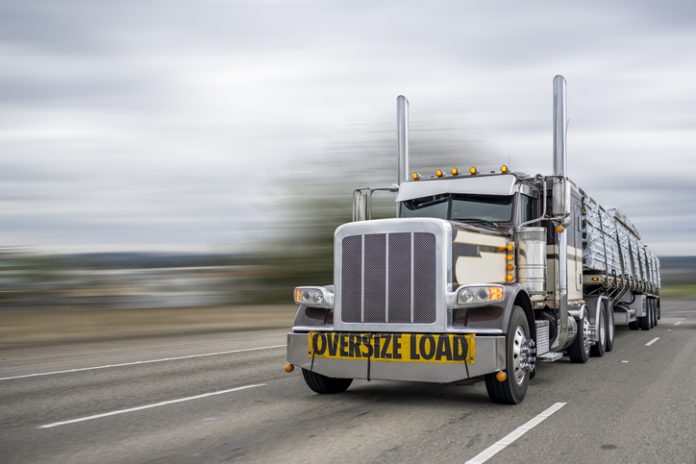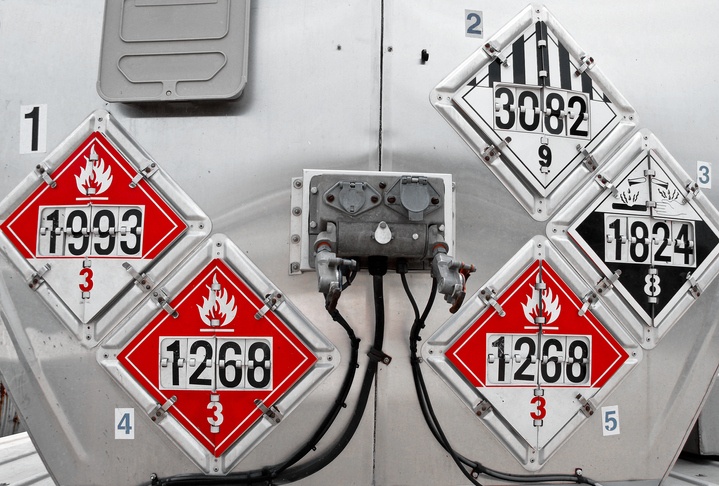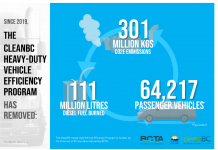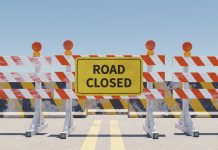
This month, I’ll go over some of the basic points of dangerous goods and oversized loads. This is in no way a complete or comprehensive article of everything you need to know regarding these 2 somewhat specialized areas of driving, but they will give you the groundwork and basics for hauling them.
In Canada, your employer is responsible for training you in the safe handling and transportation of dangerous good. After the training course, you should have received a dangerous goods driver’s handbook. Keep this book handy at all times, as it contains the most recent revision of the dangerous goods rules and regulations, as they can and do change from time to time. That being said, it is nearly impossible for someone to remember everything they need to know in regards to hauling dangerous goods. I’ve been doing it for over 30 years, and I still have to look items up almost every time.
Just to refresh our memories, there are 9 classes of dangerous goods:
- Explosives
- Flammable Gases
- Flammable Liquids
- Flammable Solids
- Oxidizing
- Toxic and Infectious
- Radioactive
- Corrosives
- Miscellaneous
Dangerous goods loads aren’t really all that much of a hassle, but they do require some preplanning before you hit the road. First off, before accepting a dangerous goods load, be sure you have taken an approved dangerous goods course and that you have your current, valid dangerous goods card in your possession. While it’s never happened to me, I know of drivers who have failed this simple check, and it has cost them and their employer dearly. Next, verify exactly what type(s) of dangerous goods, and the quantity of each type. This information will be on your shipping documents (bill of lading). The dangerous goods listing on your bill of lading must contain specific information. At minimum, it must, by law include the shipper’s name and address, the date of shipment, description of the dangerous goods in the following order: UN number, dangerous goods shipping name, primary and secondary class, (if a secondary class is applicable), the packing group in Roman numerals, the quantity in metric (L or kgs), and a 24 hour contact number to an individual who can provide technical information in case of emergency. This emergency number MUST be monitored at all times, day or night. Explosives require more information on the bill of lading, such as a compatibility group and an “NEQ” (Net Explosive Quantity) in kgs. Radioactive dangerous goods requires a separate training course, and has it’s own set of rules and regulations. I have absolutely no experience with radioactive loads, so I’ll just steer clear of their regulations.
Dangerous goods entries on the bill of lading must be listed in such a way that they are easily distinguishable from non dangerous goods. This can be by simply using a highlighter, a different font, or other means. At one time, dangerous goods were required to be listed first on the bill of lading.
As an example, the bill of lading entry for a load of gasoline would be:
“UN1203, Gasoline, Class 3, PG III”
The listing MUST be in this order: UN number (these numbers are all the same world wide), proper legal commodity name, class of dangerous goods, and packing group. (I least dangerous, III most dangerous).
As you might expect, radioactive shipping requirements are far more regulated. I have had 0 experience with radioactive, and very limited experience with explosives. All of my explosive experience was with Class 1.4D, which is the least dangerous type of explosive. It was a load of actuators for automobile airbags. Not REALLY dangerous, but because it has an expansion rate high enough, it is considered an explosive.

The next step is ensuring you have the correct placards for the dangerous goods. By law, the placards must be supplied by the shipper and they are to be affixed to the trailer before the dangerous goods are loaded, and they are not to be removed until after the dangerous goods are unloaded. Once the dangerous goods have been unloaded, the placards must be removed. The only exception being if there is still some dangerous goods residue present, such as in a liquid tanker. If your trailer has permanently attached placard holders, please use them. Some trailers may have an aluminum flip placard holder that allows you to flip through the available placards packing group numbers, and UN numbers (see photo). These are no longer legal for use, as in the event of an accident, they can become unreliable, if the impact changes the placard. Most shippers issue the least expensive placards, that are basically just decals, with adhesive backing to be (literally) stuck on the trailer. Even in placard holders, they flop around and tear, eventually falling off, so use duct tape to secure them in the placard holders. One other regulation regarding placard holders. They can only be used for officially recognized dangerous goods placards. On occasion, I see drivers have put placard shaped and sized “Have A Good Day” placards in these holders. This is now illegal, and will get you a ticket. The reason being, in the event of a collision, especially a rollover, placards can become torn, and almost illegible. Emergency responders, seeing a torn “Have a good day” placard may erroneously think there are unknown dangerous goods involved. Shippers are only required to provide the minimum number of placards (4 of each type required), so if your company hauls dangerous goods on any kind of regular basis, it would be a good idea to stock up on the most commonly used placards at a truck stop, and carry them with you. At all costs, please refrain from using the adhesive to stick them to the trailer. They are near to impossible to remove later unless you have a putty knife or pressure washer handy. You must also ensure that you have the correct type of placard for the dangerous goods being carried. Go over your shipping manifest very carefully! There are restrictions regarding dangerous goods and non dangerous goods, as well as restrictions around dangerous goods in the same class, and those in different classes. For example, you don’t want to have blasting caps and dynamite on the same trailer, unless you want to run the risk of spreading your truck, trailer, cargo and yourself over a wide swath of the country side. I know of one company that did ship blasting caps and dynamite on the same trailer. The final result was a hole in the road 20 feet wide, 20 feet long and about 6 feet deep.
Other combinations you want to avoid are flammables with oxidizers, Toxic and Infectious with food products (I once had a preloaded trailer that had rat poison and cheese on it). If at all possible, be present when the freight is being loaded, and visually inspect all the packages. All packages containing dangerous goods must have the appropriate markings. As with the placards on the exterior of the trailer, this label is required to be on all 4 sides of each package. While watching the freight being loaded, be mindful of what is all going on the trailer. If it’s a full load of one type of dangerous goods, then it’s a fairly simple process. If it’s a mixed load, then more due diligence is needed to ensure everything being loaded is safe to be transported together. IE, no dynamite with blasting caps, or food products with poisons. Most shippers will ensure that the load is properly loaded, but mistakes can occur, and if you get stopped for an inspection, and it’s found that you have freight that shouldn’t be shipped together, then the responsibility and the ticket land in your lap.
Once you have everything squared away, and everything checks out legal, where do you keep the dangerous goods paperwork? The law states that while driving, the paperwork must be within arm’s reach of the driver at all times. When you leave the truck, the paperwork must be in easy view of anyone opening the driver’s door, ideally in the driver’s door pocket, or on the driver’s seat. If you’re dropping the loaded trailer in a yard, then the bills are to be left with a designated individual at the yard, or in a waterproof container attached to the trailer. If the shipment is crossing the border, from Canada to the United States (or vice versa), then it must be in compliance with both the Canadian TDG regulations, and the United States HazMat regulations. If it’s a load from Canada to Mexico, or vice versa, then it must comply with the laws of all 3 countries. International dangerous goods shipments also require the driver(s) to be FAST (Free And Secure Trade) certified. Fortunately, Canadian, American and Mexica regulations are very similar, but there are a few minor variations. The only one I can think of, off the top of my head is, certain materials that are considered “Marine Pollutants”. These commodities require a “Marine Pollutant” placard in Canada, but the placard is prohibited (to the best of my knowledge) in the United States and Mexico. Again, the shipper (even in the United States and Mexico) is required to supply you with a minimum of 4 of these placards, but they shouldn’t be displayed until you cross the border into Canada. It’s a good idea to stop just before the Canadian border to apply them, otherwise you risk Canada Customs noticing the placards aren’t on the trailer. Chances are, they will just remind you to apply them, but then again, they might tell you to apply them, and issue a fine as well.
What constitutes an “oversized load”?
Simply put, anything being transported by road with an overall height exceeding 13 ft 6 in (4.1 metres), or 8 ft 6 in wide (2.8 metres) or extends more than 8 ft 5 in (2.6) metres beyond the back of the trailer and can not be easily reduced in size is considered over sized.
For oversized loads, the rules and regulations are so wide and varied, it was impossible to get into any kind of specifics, as there simply are no specifics, other than all oversized loads require permits for every jurisdiction, state, province and city in which you will be travelling. Read the permits thoroughly. Make certain, beyond the shadow of a doubt that you fully and completely read and understand everything in your permits. The permits will specify the allowable dimensions (height, width, length and weight). Use a quality tape measure, and a certified scale to ensure you are within the limits of the permits. Other limits that will be listed on the permits include routing, allowable travel times (when you can and can’t be on the road), whether or not escort and support vehicles are required, and the type of escort and support vehicles, and the placement of escort and support vehicles. Support vehicles and personnel may be required to move utility lines to allow an over height load to pass, or to move traffic signals to allow you room to maneuver.
The requirements for safety flags, warning lights and signage (LONG LOAD, OVERSIZED LOAD) etc will also be spelled out on your permits. My best advice is, after reading all the permits through, go with the most restrictive regulations. If you require escort vehicles, make a copy off all pages of every permit, and give them to one of the escort vehicles, and consult with them. They probably handle far more oversized loads than you ever will, so make use of their experience. I’ve been lucky so far, and other than turnpike doubles (twin 53 ft trailers), the only over sized loads I’ve had to deal with were over weight loads, so my permits only dealt with bridge weight restrictions, but that was confusing enough, as it also involved the federal bridge weight formula to determine the legal axle spacings.





















